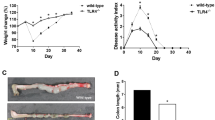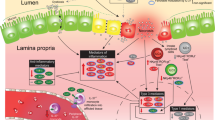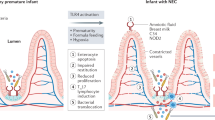Abstract
Background:
Necrotizing enterocolitis (NEC) is an immature intestinal condition resulting in devastating intestinal inflammation due to unknown mechanisms. Evidence has suggested that intestinal maturation attenuates the severity of NEC and Toll-like receptor 4 (TLR4) has been suggested to play a critical role in its pathogenesis. We investigated whether maturational effects of TLR4 expression in immature colon might contribute to the development of NEC.
Methods:
TLR4 colonocyte expression was detected by immunofluorescence confocal microscopy. Interleukin-6 (IL-6) levels were assayed by an enzyme-linked immunosorbent assay (ELISA).
Results:
TLR4 expression was high in fetal colonic epithelium in human and mouse, with earlier gestation having a higher surface/cytoplasm distribution. TLR4 remained high in mouse postnatal day 1 but the surface/cytoplasm distribution was reduced. TLR4 decreased in amount and then was expressed in crypts in the mature human and mouse colon. Hydrocortisone (HC) reduced the surface/cytoplasm distribution of TLR4 in human fetal colon. Elevated IL-6 levels in immature colon after lipopolysaccharide were attenuated by HC in human and mouse.
Conclusion:
Expression, localization, and signaling of TLR4 in colonic epithelium may be developmentally regulated. HC may accelerate the TLR developmental pathway change to an adult type, which may account for its impact on TLR4 signaling.
Similar content being viewed by others
Log in or create a free account to read this content
Gain free access to this article, as well as selected content from this journal and more on nature.com
or
References
Neu J, Walker WA . Necrotizing enterocolitis. N Engl J Med 2011;364:255–64.
Grave GD, Nelson SA, Walker WA, et al. New therapies and preventive approaches for necrotizing enterocolitis: report of a research planning workshop. Pediatr Res 2007;62:510–4.
Afrazi A, Sodhi CP, Richardson W, et al. New insights into the pathogenesis and treatment of necrotizing enterocolitis: Toll-like receptors and beyond. Pediatr Res 2011;69:183–8.
Kosloske AM . Epidemiology of necrotizing enterocolitis. Acta Paediatr Suppl 1994;396:2–7.
Beeby PJ, Jeffery H . Risk factors for necrotising enterocolitis: the influence of gestational age. Arch Dis Child 1992;67(4 Spec No):432–5.
Nanthakumar NN, Dai D, Meng D, Chaudry N, Newburg DS, Walker WA . Regulation of intestinal ontogeny: effect of glucocorticoids and luminal microbes on galactosyltransferase and trehalase induction in mice. Glycobiology 2005;15:221–32.
Hooper LV, Bry L, Falk PG, Gordon JI . Host-microbial symbiosis in the mammalian intestine: exploring an internal ecosystem. Bioessays 1998;20:336–43.
Nanthakumar NN, Young C, Ko JS, et al. Glucocorticoid responsiveness in developing human intestine: possible role in prevention of necrotizing enterocolitis. Am J Physiol Gastrointest Liver Physiol 2005;288:G85–92.
Lu L, Bao Y, Khan A, et al. Hydrocortisone modulates cholera toxin endocytosis by regulating immature enterocyte plasma membrane phospholipids. Gastroenterology 2008;135:185–193.e1.
Harju K, Ojaniemi M, Rounioja S, et al. Expression of toll-like receptor 4 and endotoxin responsiveness in mice during perinatal period. Pediatr Res 2005;57(5 Pt 1):644–8.
Chaturvedi A, Pierce SK . How location governs toll-like receptor signaling. Traffic 2009;10:621–8.
Watts C . Location, location, location: identifying the neighborhoods of LPS signaling. Nat Immunol 2008;9:343–5.
Kagan JC, Su T, Horng T, Chow A, Akira S, Medzhitov R . TRAM couples endocytosis of Toll-like receptor 4 to the induction of interferon-beta. Nat Immunol 2008;9:361–8.
Fusunyan RD, Nanthakumar NN, Baldeon ME, Walker WA . Evidence for an innate immune response in the immature human intestine: toll-like receptors on fetal enterocytes. Pediatr Res 2001;49:589–93.
Lu P, Sodhi CP, Hackam DJ . Toll-like receptor regulation of intestinal development and inflammation in the pathogenesis of necrotizing enterocolitis. Pathophysiology 2014;21:81–93.
Sanderson IR, Ezzell RM, Kedinger M, et al. Human fetal enterocytes in vitro: modulation of the phenotype by extracellular matrix. Proc Natl Acad Sci USA 1996;93:7717–22.
Nanthakumar NN, Fusunyan RD, Sanderson I, Walker WA . Inflammation in the developing human intestine: A possible pathophysiologic contribution to necrotizing enterocolitis. Proc Natl Acad Sci USA 2000;97:6043–8.
Claud EC, Lu L, Anton PM, Savidge T, Walker WA, Cherayil BJ . Developmentally regulated IkappaB expression in intestinal epithelium and susceptibility to flagellin-induced inflammation. Proc Natl Acad Sci USA 2004;101:7404–8.
Nanthakumar N, Meng D, Goldstein AM, et al. The mechanism of excessive intestinal inflammation in necrotizing enterocolitis: an immature innate immune response. PLoS One 2011;6:e17776.
Gribar SC, Anand RJ, Sodhi CP, Hackam DJ . The role of epithelial Toll-like receptor signaling in the pathogenesis of intestinal inflammation. J Leukoc Biol 2008;83:493–8.
Hackam DJ, Afrazi A, Good M, Sodhi CP . Innate immune signaling in the pathogenesis of necrotizing enterocolitis. Clin Dev Immunol 2013;2013:475415.
Leaphart CL, Cavallo J, Gribar SC, et al. A critical role for TLR4 in the pathogenesis of necrotizing enterocolitis by modulating intestinal injury and repair. J Immunol 2007;179:4808–20.
Richardson WM, Sodhi CP, Russo A, et al. Nucleotide-binding oligomerization domain-2 inhibits toll-like receptor-4 signaling in the intestinal epithelium. Gastroenterology 2010;139:904–17, 917.e1–6.
Jilling T, Simon D, Lu J, et al. The roles of bacteria and TLR4 in rat and murine models of necrotizing enterocolitis. J Immunol 2006;177:3273–82.
Abreu MT . Toll-like receptor signalling in the intestinal epithelium: how bacterial recognition shapes intestinal function. Nat Rev Immunol 2010;10:131–44.
Biol MC, Martin A, Richard M, Louisot P . Developmental changes in intestinal glycosyl-transferase activities. Pediatr Res 1987;22:250–6.
Hornef MW, Frisan T, Vandewalle A, Normark S, Richter-Dahlfors A . Toll-like receptor 4 resides in the Golgi apparatus and colocalizes with internalized lipopolysaccharide in intestinal epithelial cells. J Exp Med 2002;195:559–70.
Zanoni I, Ostuni R, Marek LR, et al. CD14 controls the LPS-induced endocytosis of Toll-like receptor 4. Cell 2011;147:868–80.
Abreu MT, Vora P, Faure E, Thomas LS, Arnold ET, Arditi M . Decreased expression of Toll-like receptor-4 and MD-2 correlates with intestinal epithelial cell protection against dysregulated proinflammatory gene expression in response to bacterial lipopolysaccharide. J Immunol 2001;167:1609–16.
Acknowledgements
D.M.: Contributed to experimental design, experiments, and manuscript preparation; W.Z.: helped with experiments and sample collection; H.S.: made suggestions for experimental design, and provided technical assistance; L.L.: made suggestions for experimental design and technical approach; V.W.: contributed to experiments; V.X.: contributed to morphologic studies; W.A.W.: made substantial contribution to concept and design and manuscript preparation. We also express our gratitude to the coordinating medical and research staff at Mucosal Immunology and Biology Research Center, Massachusetts General Hospital for Children, Boston, MA, and special thanks to Bobby Cherayil for technical support; Suzzette McCarron for manuscript organization; Meiqian Weng and Kriston Ganguli for coordination and Maureen Garron for administrative support. We also owe special thanks to Kathleen Sirois at Brigham and Women’s Hospital, Boston, MA, for sample collection.
Author information
Authors and Affiliations
Corresponding author
Rights and permissions
About this article
Cite this article
Meng, D., Zhu, W., Shi, H. et al. Toll-like receptor-4 in human and mouse colonic epithelium is developmentally regulated: a possible role in necrotizing enterocolitis. Pediatr Res 77, 416–424 (2015). https://doi.org/10.1038/pr.2014.207
Received:
Accepted:
Published:
Issue date:
DOI: https://doi.org/10.1038/pr.2014.207
This article is cited by
-
Amorphous silica nanoparticles and the human gut microbiota: a relationship with multiple implications
Journal of Nanobiotechnology (2024)
-
Sialylated human milk oligosaccharides prevent intestinal inflammation by inhibiting toll like receptor 4/NLRP3 inflammasome pathway in necrotizing enterocolitis rats
Nutrition & Metabolism (2021)
-
Premature neonatal gut microbial community patterns supporting an epithelial TLR-mediated pathway for necrotizing enterocolitis
BMC Microbiology (2021)
-
Indole-3-lactic acid, a metabolite of tryptophan, secreted by Bifidobacterium longum subspecies infantis is anti-inflammatory in the immature intestine
Pediatric Research (2020)
-
Human cathelicidin improves colonic epithelial defenses against Salmonella typhimurium by modulating bacterial invasion, TLR4 and pro-inflammatory cytokines
Cell and Tissue Research (2019)



